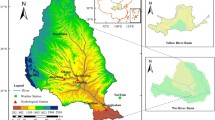Abstract
Waterlogging induced by torrential rain or typhoon in urban areas due to rapid urban development and land cover changes has been a global hotspot and a potential risk affecting urban habitant lifelines and safety. This paper analyzed the impact of land use/cover change on the surface runoff and evaluated the waterlogging risk caused by precipitation with different intensities in Pudong New Area, Shanghai. A simplified urban waterlogging model has been built for the inundated water depth simulation through the combination of both SCS model and GIS spatial analysis with the consideration of underlying surface characters in urban area. Based on the simulated depth results, waterlogging risk ranks were further established to evaluate waterlogging risk of Pudong New Area under different conditions considering social survey results. The results show that the land use structure and pattern change increases surface runoff depth. Under the assumption of a daily maximum precipitation at 200 mm, the surface runoff depth increased by 13.19 mm from 1994 to 2006 due to urbanization. On the whole, Heqing, Huaxia tourism area, Chuansha, Tangzhen and Jichang Town have high waterlogging risk rank, Gaoqiao, Donggou, urban district, Jinqiao, Caolu, Sanlin and Beicai Town have medium waterlogging risk rank, and Zhangjiang, Gaodong and Huamu Town have low waterlogging risk rank. These results provide important information for the local government, and the method of waterlogging risk assessment can also be applied in other cities to provide guidance on waterlogging risk control.








Similar content being viewed by others
References
Angela SS (2003) Natural resource management issues: South west region. Department of Agriculture of Western Australia, West Australia, pp 51–53
Dutta D, Herath S, Musiake K (2003) A mathematical model for flood loss estimation. J Hydrol 277(1–2):24–49
Hsu MH, Chen SH, Chang TJ (2000) Inundation simulation for urban drainage basin with storm sewer system. J Hydrol 234(2):21–37
Huang DP, Liu C, Peng SF (2007) Progress on assessment and regionalization of flood risk (in Chinese). Progr Geogr 26(4):11–22
Huang DP, Liu C, Fang HJ, Peng SF (2008) Assessment of waterlogging risk in Lixiahe region of Jiangsu Province based on AVHRR and MODIS image. Chin Geogr Sci 18(2):178–183
Kleist L, Thieken AH (2006) Estimation of the regional stock of residential buildings as a basis for a comparative risk assessment in Germany (in Chinese). Nat Hazard Earth Syst Sci 6:541–552
Liu M, Yang HQ, Xiang YC (2002) Risk assessment and regionalization of waterlogging disasters in Hubei Provence. Resour Environ Yangtze Basin 11(5):476–481
Ma XQ, Wang XR, Zhang AM, Xu M, Zhang JD (2002) GIS-based zoning of drought and excessive rain risks at the level of city (county) (in Chinese). Geol Anhui 12(3):171–175
Mishra SK, Tyagi JV, Singh VP, Singh R (2006) SCS-CN-based modeling of sediment yield. J Hydrol 324:301–322
Pullar D, Springer D (2000) Towards integrating GIS and catchment models. Environ Model Softw 15(5):451–459
Quan RS, Liu M, Hou LJ, Lu M, Zhang LJ (2009) Impact of land use dynamic change on surface runoff: a case study on Shanghai Pudong New District (in Chinese). J Catastr 24(1):44–49
Richard HF, Julianne JM, Charles D, James RC (2006) Use of remotely sensed data to estimate the flow of water to a playa lake. J Hydrol 325:67–81
Shi PJ, Yuan Y, Chen J (2001) The effect of land use on runoff in Shenzhen City of China (in Chinese). Acta Ecol Sin 21(7):1041–1049
Shi Y, Shi C, Xu SY, Sun AL, Wang J (2009) Exposure assessment of rainstorm waterlogging on old-style residences in Shanghai based on scenario simulation. Nat Hazards. doi:10.1007/s11069-009-9428-6
U.S. Soil Conservation Service (1972) National Engineering Handbook Section 4, hydrology. U.S. Government Printing Office, USA
Veldkamp A, Verburg PH (2004) Modeling land use change and environmental impact. J Environ Manage 72:1–3
Wang BS, Liu WY, Huang SE (2006) Risk evaluation of drought and flood in Jiangxi and agricultural sustainable development (in Chinese). Meteorol Disaster Reduct Res 29(2):43–47
Xie YY, Han SQ, You LH, Wang Y, Yan CL (2004) Risk analysis of urban rainfall waterlogging in Tianjin City (in Chinese). Sci Meteorol Sin 24(3):342–349
Xu PZ (1996) Impact of future sea level rise on flood and waterlogging disasters in Lixiahe Region. Chin Geogr Sci 6(1):35–48
Zhang XN, An R, Zhang WT (2005) Development of flood and waterlogging risk map for Shanghai City (in Chinese). J Hohai Univ (Nat Sci) 33(3):251–254
Zhao SJ, Chen ZY, Xiong LY (2004) Establishment of simplified urban waterlogging model using spatial analysis (in Chinese). J Nat Disasters 12(3):6–13
Zheng CX, Mi PQ, Chen JB, Liu M (2007) Numerical simulation and risk evaluation of rainfall waterlogging in Liuzhou City (in Chinese). Meteorol Mon 33(11):72–75
Acknowledgments
The research was supported by the National Natural Science Foundation of China (Grant No. 40730526). Special thanks are extended to editors and anonymous reviewers for their valuable comments.
Author information
Authors and Affiliations
Corresponding author
Rights and permissions
About this article
Cite this article
Quan, RS., Liu, M., Lu, M. et al. Waterlogging risk assessment based on land use/cover change: a case study in Pudong New Area, Shanghai. Environ Earth Sci 61, 1113–1121 (2010). https://doi.org/10.1007/s12665-009-0431-8
Received:
Accepted:
Published:
Issue Date:
DOI: https://doi.org/10.1007/s12665-009-0431-8




